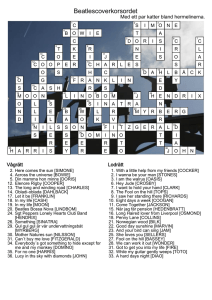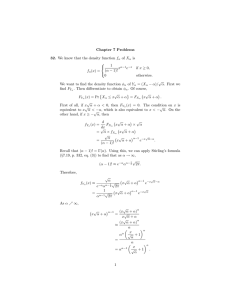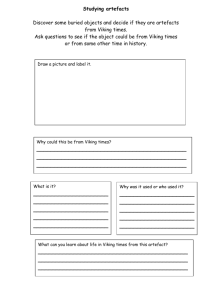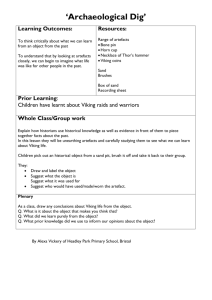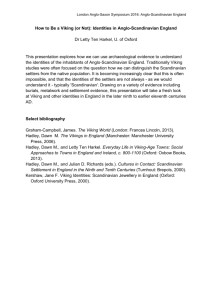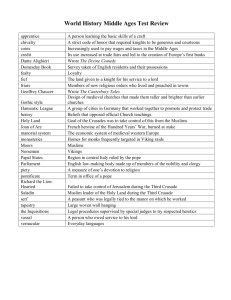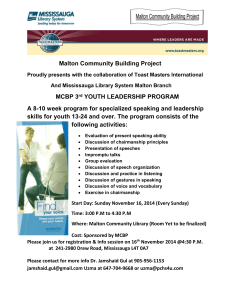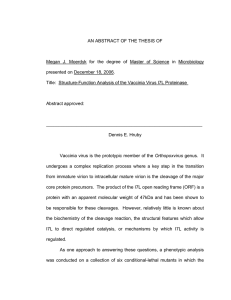STUDY GUIDE Viking and Medieval Scandinavian History
advertisement
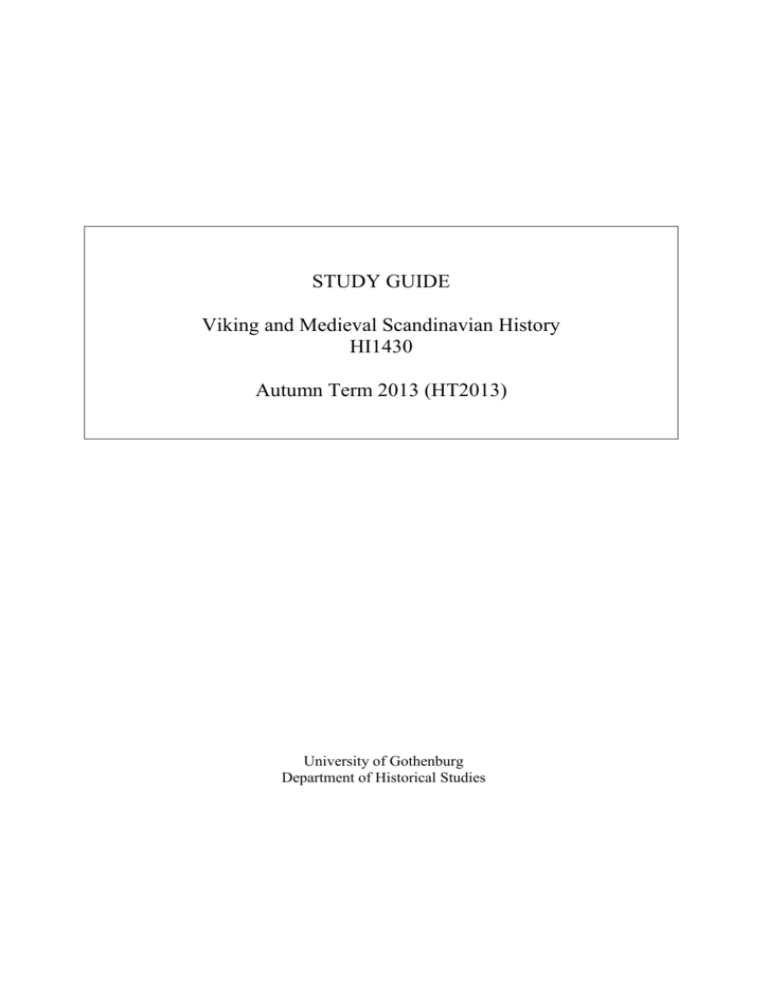
STUDY GUIDE Viking and Medieval Scandinavian History HI1430 Autumn Term 2013 (HT2013) University of Gothenburg Department of Historical Studies Study Guide, Viking and Medieval Scandinavian History, HI1430 Contents ADMINISTRATION .................................................................................................................................... 3 Address, telephone and fax ................................................................................................................. 3 Office and Reception ........................................................................................................................... 3 Lecturers on this course ....................................................................................................................... 3 THE COURSE AND ITS THEMES ................................................................................................................ 4 GRADING AND EXAMINATION ................................................................................................................ 5 1) Oral Presentation ............................................................................................................................ 5 2) Take-home Exam ............................................................................................................................. 5 COURSE EXCURSIONS .............................................................................................................................. 6 Excursion 1 – Gothenburg City Museum ............................................................................................. 6 Excursion 2 – Västergötland’s historical sites ..................................................................................... 6 REQUIRED READING ................................................................................................................................ 7 GUL – COURSE HOMEPAGE AND MESSAGE BOARD ............................................................................... 8 2 Study Guide, Viking and Medieval Scandinavian History, HI1430 ADMINISTRATION Address, telephone and fax Department of Historical Studies University of Gothenburg Box 200 405 30 Göteborg Visiting address: Renströmsgatan 6 Office and Reception Opening hours: Monday-Thursday, 10:00-12:00 and 13:00-15:00 Fridays, closed Services available: - Registration at the department - Request certificates of study (stamped and signed) - Request certificates for completed courses and course work - Make changes to your address and telephone number - Notify the department of any break in or termination of your studies Lecturers on this course Sara E. Ellis Nilsson, Course Coordinator (sara.nilsson@history.gu.se) Elisabeth Arwill-Nordbladh (elisabeth.nordbladh@archaeology.gu.se) Henrik Janson (henrik.janson@history.gu.se) 3 Study Guide, Viking and Medieval Scandinavian History, HI1430 THE COURSE AND ITS THEMES This course, as outlined in the syllabus, focuses on the history of Viking and Medieval Scandinavia. It covers the time period from about 700 to the end of the Middle Ages in the sixteenth century. The course offers an interdisciplinary approach to the subject by means of exploring both historical and archaeological perspectives. The main features of Scandinavian history in the time period are covered, focusing on the political, economic, cultural, religious and social changes that occurred. A lot of attention is given to the influence of Christianity and the Church in the Scandinavian countries, which also includes the differences and similarities between Scandinavia and the rest of medieval Europe. In addition, the course touches on Scandinavia’s integration into medieval Christian Europe and its role as a cultural and economic unit. Other important aspects are the state-building process and political culture, as well as a gender history perspective on social development. The main themes of the course have been divided up into individual lectures as follows (see also the current term schedule): Who were the Vikings? Sources: archaeological versus historical Different views on society and social actors Viking expansion in the west Viking expansion in the east Conversion and Christianisation State formation Urbanisation Christianisation and Organisation Gender and Power Cultural Changes Kingdoms and States The current term’s schedule includes the relevant themes and readings for each lecture (see the course’s homepage on GUL). 4 Study Guide, Viking and Medieval Scandinavian History, HI1430 GRADING AND EXAMINATION Your grade for the course will be based on the following assignment and examination: 1) An in-class oral presentation 2) A take-home exam The due dates are found on the term schedule. 1) Oral Presentation For this assignment you are required to form groups of about 3-5. Each group must chose a topic connected to one of the course’s themes and write a 3-4 page paper/report. The in-class oral presentation consists of a summary of the paper/report and should last for about 10 minutes. Instructions and information, as well as suggestions for presentation topics, will be posted on GUL. You are welcome to contact any of the lecturers if you need help choosing or are uncertain if your topic is appropriate. Groups are to inform the Course Coordinator of their topic choice at least two weeks before the date of presentation (see schedule). Names and email addresses of those in the group should also be provided. In order to achieve a Pass (P), you are required to attend this lecture and present with your group. If you are unable to attend, please contact the Course Coordinator and you will be given the opportunity of retaking the assignment. Completion of this assignment is required in order for you to receive your final mark. 2) Take-home Exam The final examination for this course is in a take-home format. Three questions based on the required reading and lectures will be posted on GUL on the evening of the last lecture (see schedule). Choose two of the three topics and answer in two separate essays. Include both essays in one document which can be uploaded to GUL before or on the due date (see schedule). By uploading to GUL, you are offered the option of remaining anonymous. More detailed information, including the exam questions, will be provided at the last lecture and on GUL. In this exam, as in all academic papers, you are required to cite your sources. In this course the form of citation is optional. You may use Harvard, Oxford, etc. Please refer to the university’s citation guide, a link to which is provided on the course homepage on GUL (lefthand side). Grades that may be assigned to your essays are Pass with Distinction (VG), Pass (G) and Fail (IG). Submission of this exam is required in order to receive a mark for this course. Completion of BOTH the oral presentation and the take-home exam is required in order for you to receive your final mark and course credits. This course is equivalent to 15 ECTS. Please see the course syllabus for more information. 5 Study Guide, Viking and Medieval Scandinavian History, HI1430 COURSE EXCURSIONS This course offers two excursions to places related to its themes. Please see the term schedule for dates. Excursion 1 – Gothenburg City Museum This excursion will take place during the museum’s evening opening hours on a Wednesday (see schedule). We will meet at about 18:00 and explore the Viking and medieval displays together as a group. The entrance fee is provided. There is no deadline to sign up for this excursion. Excursion 2 – Västergötland’s historical sites During this excursion, which will take place on a Saturday, we will spend the day exploring a number of historical sites throughout Västergötland. The bus tour usually lasts from about 8:30am until 18:30pm. We usually visit Hols burial ground, Skara, Varnhem and Gökhem or Sparlösa and Stora Levene. All entrance fees and lunch are provided unless otherwise indicated. An itinerary will be available on GUL at the start of term. The last day to sign up for the trip will be announced at the first lecture. Both excursions are optional and not included in the course examination. However, they are good opportunities to see some of what we have been studying first hand. 6 Study Guide, Viking and Medieval Scandinavian History, HI1430 REQUIRED READING Brink, Stefan & Neil Price. The Viking World. London & New York. 2008. (Can be downloaded as an e-book from the University of Gothenburg Library, follow link on GUL) Helle, Knut (Ed). The Cambridge History of Scandinavia. Volume I. Prehistory to 1520. Cambridge 2003. (Can be downloaded as an e-book from the University of Gothenburg Library, follow link on GUL) Winroth, Anders. The Conversion of Scandinavia : Vikings, Merchants, and Missionaries in the Remaking of Northern Europe. New Haven 2012. Course Compendium: 1) Arwill-Nordbladh, Elisabeth. “A Reigning Queen or the Wife of a King – Only? Gender Politics in the Scandinavian Viking Age”, in Sarah Milledge Nelson (ed.). Ancient Queens: Archaeological Explorations. Oxford 2003. 19-40. 2) Janson, Henrik. “The Christianisation of Scandinavia and the end of Scythia”, 2010. 197-210. 3) Janson, Henrik. “Scythian Christianity” in Ildar Garipzanov and Oleksiy Tolochko (eds.). Early Christianity on the Way from the Varangians to the Greeks. Kiev 2011. 33-57. 4) Janson, Henrik. “Edda and Oral Christianity. Apocryphal Leaves of the Early Medieval Storyworld of the North” in Lars Boje Mortensen, Tuomas M. S. Lehtonen (eds.). The Performance of Christian and Pagan Storyworlds. NonCanonical Chapters of the History of Nordic Medieval Literature. Brepols 2013. 5) Stalsberg, Anne. "Women as actors in North European Viking Age Trade", in R. Samson (ed.), Social Approaches to Viking Studies. Glasgow 1991. 75-83. The article compendium for the course is available for purchase at “Repro”. 7 Study Guide, Viking and Medieval Scandinavian History, HI1430 GUL – COURSE HOMEPAGE AND MESSAGE BOARD Besides the lectures, the main means of communication will be via the course’s homepage and message board on the University of Gothenburg’s learning management system (GUL). GUL is a web-based platform with events and virtual rooms for information, communication and collaboration between teachers and students. To access the full content of this course on GUL you need to login to the Student Portal and to have registered for the course. The course is also available on GUL’s open pages: http://www.gul.gu.se After you have activated your Student Account and are registered, you can login to GUL via http://portalen.gu.se. If you have any questions about logging in or the Student Portal see http://www.utbildning.gu.se/education/academic-life/ You have to be registered for the course in Ladok to gain full access to the course’s homepage and message board inside of GUL. Links to the required reading that is available as e-books are provided on the homepage at the left-hand side (see “Links”). The course’s message board will be frequently updated with information of interest to the course. The message board will also be used to send reminders or supplementary information about the lectures, excursions, course administration, etc. If you have any questions about this course on GUL, please contact the Course Coordinator. For technical enquiries, please contact gulinfo@gu.se. 8
